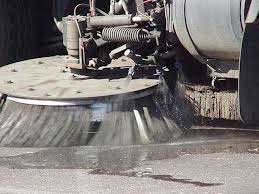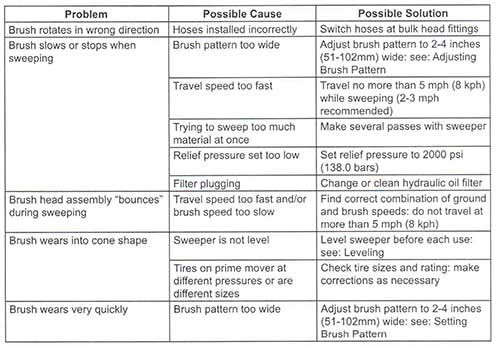Best Management Practices for Street Sweeping |

Gutter and main brooms are one of the major wear items on a sweeper. In this article, Brett Wise of Oregon-based Owen Equipment offers an overview on how to ensure you get what you need out of your gutter/curb and main brooms: long life and effective cleaning.
by Brett Wise, Owen Equipment Every sweeping operation has them: the operator that has been diligently doing his job for twenty years and knows everything about sweeping – the way s/he does things is THE way, and the ONLY way. Then, on the other end of the spectrum is the greenhorn operator that worked in the sewer department the past couple of years and was recently moved to the street department. No matter the level of experience, there are common mistakes that operators make that not only make their machine less productive, but also reduce the wear life of their brooms. Let's go through the ones that are the most prevalent and address how to correct them.
Too Much Down PressureThis is the most common mistake operators make. If you really want to dig the debris out of every nook and cranny, amp up the down pressure, right? Wrong. Operators need to remember the main function of the vehicle they are driving, and that is to SWEEP. If you crank up the down pressure, it turns the brooms into more of a mop, which dutifully pushes the material down the road but does not flick it into the area of the sweeper that picks it up. Since a higher down-pressure also causes more of each broom bristle to be in contact with the road, broom wear life is severely affected. Uneven bristle wear is a sure sign that too much down pressure is being applied. This bad habit can be corrected by simply increasing operator awareness of the job of the brooms. Remember: SWEEP not MOPThe side broom down pressure should be adjusted so that material is flicked into the path where it can be picked up by the pickup head, nozzle or main broom. In the case of a mechanical sweeper, a four-inch contact patch is standard. Some operators think that a higher down pressure means that they can get down into the dips of the road easier – that's actually addressed more efficiently by air cylinder actuated gutter brooms that keep in better contact with the road than hydraulic gutter broom mechanisms. Incorrect Side Broom TiltFor the vast majority of streets, a harsh broom angle is not needed. The exception, of course, is a street with deep gutters that are tough to reach without an aggressive angle. Too many operators tilt the side brooms at too great of an angle which causes sweeper inefficiency as only part of the side broom is in contact with the road surface. Also, many times a strip of debris will be left behind when the pickup head or main broom passes the area that wasn't in contact with the side broom. For the vast majority of road surfaces, a proper 5-degrees out; 5-degrees forward tilt setup is ideal. Be sure to make adjustments as your brooms wear out to maintain the proper forward angle. Sweeping Too FastEach sweeper's ideal speed-to-efficiency ratio may be different, but oftentimes operators are driving too fast for successful sweeping. It's not a race; remember, the goal is to remove all of the material from the roadway. Most sweepers should be operated at a maximum speed of 5 MPH to do their job well. Slow and steady wins the sweeping race! Routes should be properly mapped so that an operator can move at the proper speed and still complete their assignment for the day. Letting Brooms Wear Out Past Their Proper LengthIf a side broom is allowed to wear out past the cutoff length, it doesn't flick the material into the pickup path. The same can be said for a main broom that loses its ability to flick material onto the conveyor or elevator. For a full-size sweeper, promote the idea of using the long edge of a dollar bill to measure bristle length for side brooms. If bristle length gets shorter than that dollar, you are throwing money away in fuel and labor costs due to the loss in productivity.
While all of the above are simple things – when you know about them and practice them – making sure operators are aware of the basics is a must for running an efficient sweeping operation.Jack Moran, long-time salesperson for Keystone Plastics, also offers the following as a troubleshooting guide for tube broom operation: 
Brett Wise has been involved in the power sweeping industry for the past six years. Owen Equipment is the Vactor and Elgin dealer for the Northwest, with offices in Kent, WA, Portland, OR, and Fairfield, CA. The company also sells replacement brooms, parts, and service for all sweeper brands. You may reach Brett via email. You may reach Jack Moran via email or through the Keystone Plastics website. |
© 2005 - 2019 World Sweeper
|
Street Contents
|